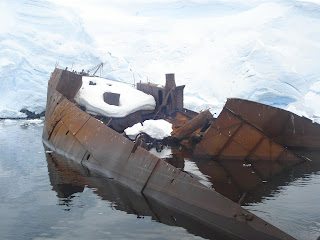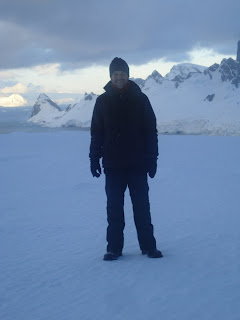Friday 4 December, Deception Island - 04h00: 62°48.4 South / 060°08.7 West
- 08h00: 62°57.3 South / 060°37.8 West
- First anchor: 62°53.6 South / 060°40.6 West
- Telefon Bay: 12h00: 62°57.9 South / 060°37.8 West
- 24h00: 63°01.9 South / 060°31.2 West
23h00: The best day of the trip so far for me. Overnight we departed our anchorage at Half Moon Bay to head south west along the coast of Livingstone Island towards Deception Island. Calling Deception an Island is, well, a deception: it is in fact a volcano crater, with a sheltered bay in the middle. I was hoping it would prove to be deception in the English sense and not a French “deception” – more of a disappointment. Any worries one might have had on that point were quickly laid to rest as we arrived at the island: the entrance, Neptunes Bellows is narrow, with shallow rocks in the middle making a ship’s passage just that more difficult.

We were slated to enter at 7am and sods law I slightly overslept and missed the grand entry! However, this night at 00h30 will provide an opportunity for a re-run!
Deception Island is perhaps best known for the safe sanctuary it provided to whalers at the beginning of the 20th century, moving inexorably southwards after having wiped out the colonies further north. The rather obviously named Whalers’ Bay is located directly to the north of Neptunes Bellows. However, our day was due to end there – not begin. First, we headed to the north of the bay, towards the rather oddly named Telefon Bay (I’m going to have check why it has this name!). We first anchored on the western shore where we proceeded to hike for around three hours in the area of Cross Hill.

It was an inspiring walk, the weather seemingly changing on several occasions, from the fog and cloud of early morning to clear skies and bright sun towards midday.

The views were simply stunning. This was good as the island did not offer a great deal of wildlife given its volcanic nature.

Saying that, the seals and ubiquitous penguins were on hand to greet us, and very welcome they were too.

On the way back down, we delighted in some improvised sledging down the slopes – this was great fun. However, we have undertaken to be more prepared for future occasions – plastic sheeting at a bare minimum.
Following a hearty lunch back on Europa – including hotdogs on deck – we made the short hop across the bay to the eastern side. Here, the major attraction was the warm shallow waters, heated by the volcanic beach. Most of the crew stripped off and took a dip.

I was happy to watch proceedings and take a walk along the beach to take some more photos of the incredible scenery, lots of small icebergs dotted the shallows and the still surface of the bay, providing a spectacular foreground for the view across to the other side. On the way back along the beach, I came across two penguins. Sitting down on the beach the normal 5 meters or so away from them, I decided to relax and lay down on the warm pebbles whereupon one of the penguins wobbled over towards and came right over to my foot!

Alternately looking at me, the beach, Europa, and the swimmers below, he seemed to be mulling the understandable question “what the hell??” Or perhaps he was just too used to it all, too blasé. Can our penguin friends be blasé as well as stress free? What great animals.
In the early evening we motored south back across the bay, heading for Neptunes Bellows. We took a pause in the middle of the bay to allow the ship in front of us time to quit Whalers’ Bay (I kid you not!) which provided an opportunity for a drink on the foredeck with a good read.

Unbeatable setting as the sun started setting – slowly – over the western hills.

After dinner we were able to enter Whalers’ Bay and appreciate the horror and folly of what was committed here, in a relatively short time-span between 1905 and the early 1930s.

In a pretty considerable twist of fate, the old buildings have now been deemed sites of historical interest and so are left on the beach. One can still see the old boilers which were used to boil down the whale carcasses and bones, as well as the storage vats.

All remarkably preserved, unlike the whales. Towards the end of World War II the British set up a scientific station, but it, together with other bases on Deception, were wiped out by a volcanic eruption in the late 1960s. In places, one can see the twisted metal remains of old bases.

A haunting presence on the beautiful snowy beaches. Currently Deception has two active bases, one Spanish and a smaller Argentine base. In past decades, bases, particularly those from the UK, Argentina and Chile, were less concerned with scientific research and more interested in planting a flag (both metaphorically and physically) on parts of the Antarctica, given they all had (read have) competing claims on this territory.

When the capitals would, from time to time, issue edicts to their bases instructing them to deliver a formal complaint to one of the other bases, the crews would usually take this as an invitation for the hosting of a party in the base receiving the formal warning! International cooperation working smoothly.
 Writing after breakfast now on Saturday 5 December, a short update on our departure from Deception around midnight. I was glad to have stayed up for it as the Europa had to patiently push her way through the pack ice.
Writing after breakfast now on Saturday 5 December, a short update on our departure from Deception around midnight. I was glad to have stayed up for it as the Europa had to patiently push her way through the pack ice.
 I finally had an inkling of the kind of scene faced by countless explorers, none more so than Shackleton whose story I had been reading prior to departure. With the sky still light even post midnight, we inched forward, the permanent crew and an interloper (me) on the bow keeping a lookout and trying to identify the best way through. Initially we took the direct route: pushing the Europa slowly, but firmly into the ice pack.
I finally had an inkling of the kind of scene faced by countless explorers, none more so than Shackleton whose story I had been reading prior to departure. With the sky still light even post midnight, we inched forward, the permanent crew and an interloper (me) on the bow keeping a lookout and trying to identify the best way through. Initially we took the direct route: pushing the Europa slowly, but firmly into the ice pack.
 The ice bunched up and compressed, but didn’t yield to the pressure of the hull. Following some consultation and consideration of the rock obstacles in front of us the decision was taken to steer to port, closer to one side of the promontory.
The ice bunched up and compressed, but didn’t yield to the pressure of the hull. Following some consultation and consideration of the rock obstacles in front of us the decision was taken to steer to port, closer to one side of the promontory.
 The ice here was less compact and we eventually pushed through, the ice either cracking under the bow or being forced aside, crashing into adjoining flows like giant pieces of a puzzle. Eventually, we were free. On the starboard side behind Deception’s mountains, the sunset lingered on the horizon providing the perfect backdrop to an excellent day.
The ice here was less compact and we eventually pushed through, the ice either cracking under the bow or being forced aside, crashing into adjoining flows like giant pieces of a puzzle. Eventually, we were free. On the starboard side behind Deception’s mountains, the sunset lingered on the horizon providing the perfect backdrop to an excellent day.


































































